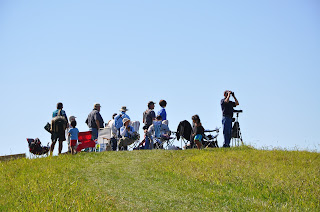 |
| Red-eyed vireos can't resist a fruiting magnolia tree in the fall. They pluck the berries from the cone-like seed pods and swallow them whole. (photo by jt893x) |
(published 11-4-21)
About 20 years ago, my wife planted a sweet bay magnolia (Magnolia virginiana) in our side yard. It grew quickly, blossomed in the spring, and stayed out of the way. I never paid much attention to it.
But after this fall, I will never look at the tree the same way. Now I call it the Magic Magnolia.
For two weeks in September, red-eyed vireos and Swainson’s thrushes called it breakfast, lunch and dinner. They picked the tree clean, harvesting the bright orange berries from the cone-like seed pods.
The feeding frenzy was fun to witness from our dining room window, especially the vireos. They were almost within reach, hopping around in the magnolia like kids in a bouncy house, sometimes hovering like kinglets to grab the fruit.
Has this avian sideshow been going on every September? Had I just been missing it? As a devoted yard birder, it hurts to ask.
It began with a sound, and I had no idea who was making it. I’m familiar with many bird songs but call notes can be tricky. This one, a harsh mew or whine, came from the magnolia. I tracked it down and found a red-eyed vireo—the same bird known for singing all day, constantly, from up high in our deciduous forests. Take a hike in June or July and you’ll often hear (but not see) the “preacher bird.” So, what’s it doing way down here, sounding almost like a catbird?
Feeding, of course. At times the magnolia hosted four vireos at once, along with a Swainson’s thrush or two. I learned that the beanlike berries of the magnolia, which ripen in August and contain magnolia seeds, are indeed a favorite food of red-eyed vireos in the fall. The fruit is high in oil, providing essential energy for southbound migrants. Our magnolia was a living fuel station, serving up Red Bull in a convenient berry format!
 |
| It’s usually a challenge to see the red eye of a red- eyed vireo. This one is holding a magnolia berry, which contains the magnolia seed. (photo by jt893x) |
Both species are primarily bug eaters during their breeding seasons. In the fall, their diets change, turning more to berries and seeds. This makes sense, because fewer insects are available, and because the adults are finished raising their families. Fledglings require the high-protein content of invertebrates.
When looking into this, I found several books that claimed red-eyed vireos eat nothing but fruit in the winter. This surprised me—I always assumed that one reason songbirds went south was to enable their insectivorous diets.
A quick check-in with a prominent birdman proved helpful. Doug Stotz, senior conservation ecologist at Chicago’s Field Museum, disagreed that red-eyed vireos eat only fruit in the winter. He’s seen them foraging for insects in the tropics. But he did confirm that fruit comprises most of a vireo’s winter diet, and the same goes for Swainson’s thrush. Lots of species follow this eating pattern.
 |
| Like other long-distance migrants, the Swainson’s thrush, a cousin of the robin, brings a hearty appetite when it travels through our region in the fall. (photo by Jerry Ting) |
A berry is a lot easier to catch than a flying wasp. Following a long migration, and during their non-breeding “off-season,” it’s understandable that birds would favor quick and easy meals.
Stotz also noted how some migratory insectivorous species manage to survive Chicago winters by shifting to a fruit-heavy diet, citing American robin, hermit thrush, northern flicker, and yellow-rumped warbler as examples.
Red-eyed vireos and Swainson’s thrushes are not candidates to stick around and see their first snow. By mid-October or sooner they’ve left our region, winging their way south and replenishing their tiny fuel tanks as they go. The deeper they get into Dixie the easier it becomes to find magnolia trees and other food-rich vegetation to sustain their transcontinental journeys.
Next September, I’ll be watching our magnolia carefully—the same tree I once ignored. As I’ve always known but never quite internalized until this fall, feeding the birds is more than putting up feeders. Most migrating species have no interest in backyard seed handouts, but they most certainly will visit fruit-bearing trees and shrubs. They find them because they need them.
Yes, I thanked my wife for planting the sweet bay magnolia, and all the other woody plants she’s brought home over the years. She always told me the birds will love them, and she was right. I’ve seen the magic.
















